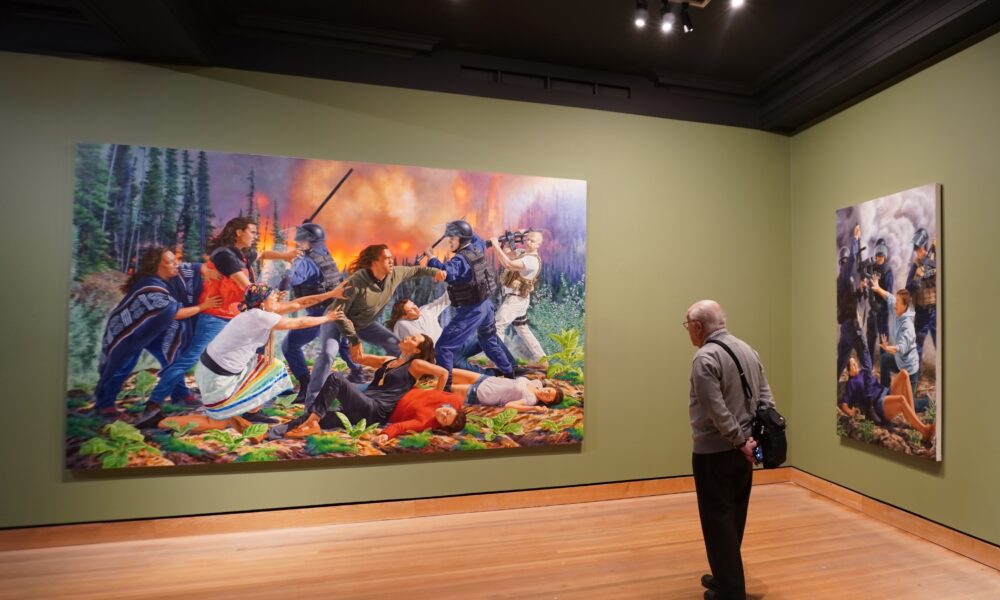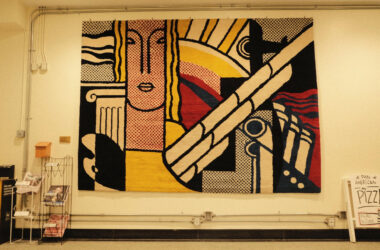In a world where history is painted by the victor, Kent Monkman takes on a personal challenge to tell an equally biased history, one painted by his subversive, heel-clad, hypersexual alter-ego Miss Chief Eagle Testickle.
Monkman, a world-renowned queer and two-spirit artist from the Fisher River Cree Nation in Manitoba, forms his new exhibition, History is Painted by the Victors, around themes of resilience, loss, colonization, and the social ostracization and oppression of sexual and gender diversity.
Monkman crafts the genderfluid character of Miss Chief to be simultaneously hyperfeminine in expression while possessing a commanding masculine authority. Using Miss Chief to explore themes of the artist’s ego, Monkman aspired to mock the colonial-era practice of artists such as George Catlin, who inserted themselves heroically into the battlefields they painted. Monkman places Miss Chief dramatically at the center of each piece, where she comedically seems to always steal the stage.
The humour of her placements and renditions of the colonial narrative bring forth questions of the era’s commonly accepted truths. The exhibition plays with the idea that colonial-era painters were heavily twisting their paintings to fit harmful narratives, such as the ‘Pristine Myth,’ which depicted the pre-colonial West as virginal and uninhabited, as well as that of the ‘Noble Savage,’ which portrayed Indigenous people as a stoic, dying race. These myths fall under the harmful ideas of ‘Manifest Destiny,’ by which colonizers perceived themselves as ordained by God to bravely conquer the western lands they saw as ripe for the taking.
Flipping narratives and channelling the idea of power through sex, the exhibition has the recurring visual of Indigenous men sexually dominating white cowboys against contrastingly serene landscapes typical of settler-colonial paintings. As intended, the scene comes off humorously shocking, but raises a very serious point: The frequent characterization of Indigenous people as a dying race submitting to the conquest of the white man is just as outlandish and fabricated as the scenes and narratives in Monkman’s work.
Thematically, the exhibition presents a whimsical, provocative lens on the key issue of marginalization. Monkman’s work starts with flamboyantly dressed Indigenous Peoples lounging in the serenely depicted Sierra Nevada, poking fun at the myth of empty land prior to European westward expansion; it quickly shifts into the more seriously depicted tragedy of residential schools, police brutality toward Indigenous Peoples, and the violence perpetuated against Indigenous women.
Although Monkman’s work is a narrative of past events and a sombre window into how histories are often mediated, many of his paintings come across deeply hopeful. With the ambitious goal to ‘decolonize Canada,’ his work is highly popular among young, 2SLGBTQIA+, and university audiences. Monkman creates the refreshing image of a queer, inclusive, Indigenous future; a radical standpoint, as under the colonial vision, many of the communities he depicts were not intended to survive into the 21st century.
Despite its dramatic historical reimagining, the exhibition is not a fabrication of equal falsehood to the myths it counteracts. The sexually liberated and loudly queer characters of Monkman’s image show a genuine window of Indigenous two-spirit acceptance that was restricted by colonial society. The Indigenous domination of white settlers demonstrates the historic factuality of hundreds of years of anti-colonial resistance. History is Painted by the Victors is a vibrant, surreally portrayed truth of who and what have always existed in North America.
History is Painted by the Victors opened on Sept. 27 and runs until March 8, 2026. It is the largest solo exhibition of Monkman’s work, and can be seen at the Montréal Museum of Fine Arts on rue Sherbrooke.









